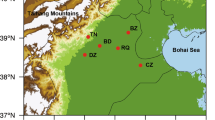Abstract
A boundary-layer field experiment in the extremely arid northern part of Chile was carried out in July, 1970. Captive radiosonde data, pibal soundings and surface observations in a three-point zonal cross-section at 23 deg lat. S are analyzed. Evidence of a thermal response in the boundary-layer circulation and daytime subsidence enhancement is presented. Surface windspeeds seem to increase in the general upslope direction while wind components along the contour lines are apparent in the central strip, in accordance with earlier results for Pampa de la Joya, Peru.
Similar content being viewed by others
References
Gutnick, M.: 1958, ‘Climatology of the Trade Wind Inversion in the Caribbean’, Bull. Am. Meteorol. Soc. 39, pp. 410–420.
Lettau, H.: 1967, ‘Small to large scale features of boundary layer structure over mountain slopes’, Proc. Symposium on Mountain Meteorology. Fort Collins, Colorado.
Lettau, H. H.: 1972, Personal communication.
Lettau, H. H.: 1976, ‘Dynamic and energetic factors which cause and limit aridity along South America's Pacific coast’, Chapter 4 (Appendix I) in World Survey of Climatology, Vol. 12. Climates of Central and South America, (W. Schwerdtfeger, ed.). Elsevier Pub. Co., the Netherlands.
Lettau, H. H.: 1978, ‘Explaining the World's Driest Climate’, Chapter 12 in Exploring the World's Driest Climate, Report 101, Center of Climatic Research, IES, University of Wisconsin, Madison, Wis.
Lydolph, P.: 1973, ‘On the causes of aridity along a selected group of coasts’, Chapter 9 in Coastal Deserts: their natural and human environments. (D. H. Amiran and A. W. Wilson, Eds.). The University of Arizona Press.
Miller, A.: 1968, ‘Wind profiles in west coast temperature inversions’. Report No. 4 San José State College. Dept. of Meteorology. Univ. of California, San José, March 1968.
Miller, A.: 1976, ‘The Climate of Chile’. Chapter 3 in World Survey of Climatology, Vol. 12 Climates of Central and South America. (W. Schwerdtfeger, ed.). Elsevier Pub. Co., the Netherlands.
Rutllant, J. and Sippa, J. 1971: ‘Algunas Características de la Inversión de Subsidencia del Anticiclón Subtropical’. Internal Report Meteorological Section. Department of Geophysics, University of Chile, Santiago. March 1971.
Rutllant, J., Ulriksen, P., Sippa, J., Salinas, H., and Doerr, L.: 1972, ‘Resultados de la Campaña de Mediciones Meteorológicas realizada en la provincia de Antofagasta’, Publicación No. 140, Department of Geophysics. University of Chile, Santiago.
Trewartha, G.: 1961, The Earth Problem Climates. The University of Wisconsin Press.
Van Loon, H., Taljaard, J., Sasamori, T., London, J., Hoyt, D. V., Lavitzke, K., and Newton, C. W.: 1972, Meteorology of the Southern Hemisphere, Monograph Vol. 13, No. 35. American Meteorol. Soc., Boston, Mass.
Author information
Authors and Affiliations
Rights and permissions
About this article
Cite this article
Rutllant, J., Ulriksen, P. Boundary-layer dynamics of the extremely arid northern part of Chile. Boundary-Layer Meteorol 17, 41–55 (1979). https://doi.org/10.1007/BF00121936
Received:
Issue Date:
DOI: https://doi.org/10.1007/BF00121936




